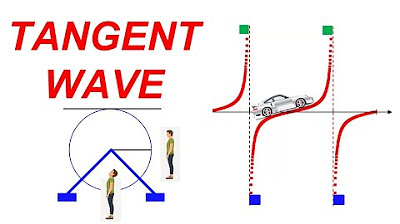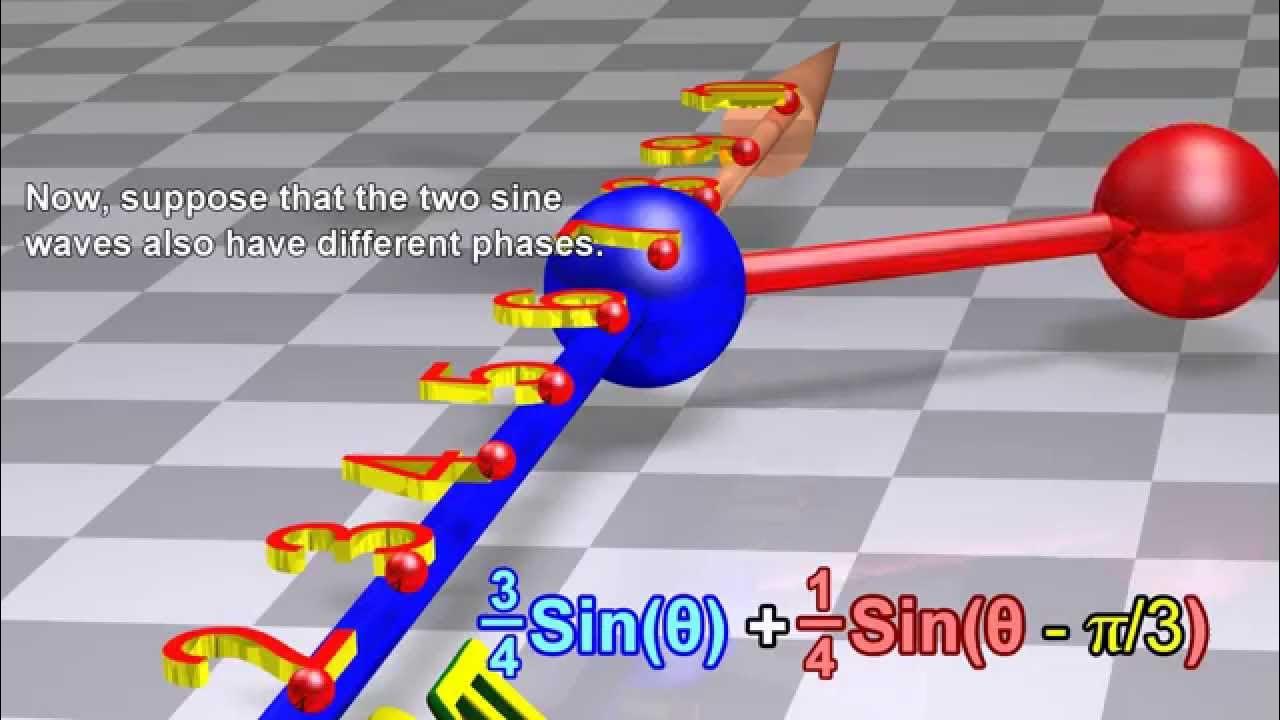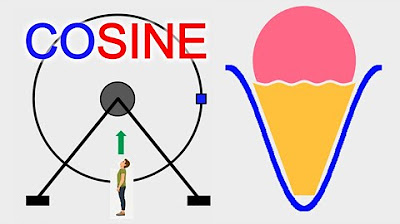Sine Wave | Simple Explanation on a Giant or Ferris Wheel | Trigonometry | Learnability
TLDRThis educational video explores the concept of sine waves, drawing an analogy with the motion of a giant wheel, such as the Hong Kong Observation Wheel or the London Eye. It explains how the vertical and circular motion of a point on the wheel can be simplified into a one-dimensional vertical motion, which forms the sine wave shape. The video clarifies that the sine wave's amplitude and frequency are influenced by the size and speed of the wheel's rotation. It also delves into the etymology of the word 'sine,' tracing its origins back to Sanskrit and Arabic before becoming 'sinus' in Latin and eventually 'sine' in English. The video concludes with a question to engage viewers and a playful suggestion to refer to sine waves as 'arda jail waves' for a humorous twist.
Takeaways
- 📚 The script explains the concept of sine waves and their relation to circular motion, such as that of a Ferris wheel.
- 🌐 It uses the Hong Kong Observation Wheel (similar to the London Eye) as an analogy to describe the formation of a sine wave.
- 🔴 The red square's vertical movement on the wheel, when viewed from the side, traces out a sine wave pattern over time.
- ⏱️ The sine wave's shape is derived from the one-dimensional vertical movement of an object on a two-dimensional circular path.
- 📉 A sine wave oscillates back and forth between a start position and its maximum amplitude in either direction.
- 🔍 The amplitude of the sine wave increases with the size of the circular motion's radius, while the frequency depends on the speed of rotation.
- 🔄 Sine waves repeat over time, similar to the continuous rotation of a wheel.
- 📈 The script introduces the concept of plotting a sine wave against an angle (phi) instead of time, with the angle measured in degrees.
- 📚 The etymology of the word 'sine' is traced back from Sanskrit to Arabic, and eventually to Latin and English, with a humorous twist on its meaning.
- 🤔 The video ends with a question for viewers to determine which wheel (red or blue) is rotating faster based on the graph provided, hinting at the importance of observing the axes.
- 😉 The script humorously suggests that the horizontal component of circular motion could also have been named, like 'cosine wave'.
Q & A
What is the primary subject of the video?
-The primary subject of the video is to explain the concept of sine waves, their shape, and their relation to circular motion, using the example of a giant wheel like the Hong Kong Observation Wheel or the London Eye.
How does the video explain the shape of a sine wave?
-The video explains the shape of a sine wave by relating it to the vertical motion of a point on a giant wheel as it rotates in a circular path. The up and down movement of the point, when plotted on a time axis, forms a sine wave.
What is the term used to describe the maximum amount in either direction that a sine wave oscillates?
-The term used to describe the maximum amount in either direction that a sine wave oscillates is 'amplitude'.
How does the size of the giant wheel affect the amplitude of its sine wave?
-If one giant wheel is bigger than another but both take the same amount of time to complete one rotation, the sine wave of the larger wheel will have a greater amplitude, meaning it will be stretched more in the vertical direction.
How does the speed of rotation of the giant wheel affect the frequency of its sine wave?
-If a giant wheel rotates faster, completing a cycle in less time, its sine wave will have a higher frequency, meaning the oscillations will occur more rapidly, and the wave will be stretched more in the horizontal direction or time axis.
What is another way to plot a sine wave according to the video?
-Another way to plot a sine wave, as mentioned in the video, is by using position versus an angle instead of time. The angle is measured from a horizontal line to a vertical line, and the time axis is changed to the angle or phase measured in degrees.
What is the significance of 360 degrees in the context of plotting a sine wave with an angle?
-In the context of plotting a sine wave with an angle, 360 degrees signifies one complete oscillation or cycle, which is the same as returning to the starting position at 0 degrees.
What is the origin of the word 'sine' as explained in the video?
-The origin of the word 'sine' can be traced back to AD 499, where a mathematical term in Sanskrit, used in India, was called 'jya', meaning half chord. This term evolved into 'jiva', then 'jibba' in Arabic, and was translated to 'sinus' by Latin translators, which eventually became 'sine' in English.
What was the original meaning of the word 'sinus' in Latin that was used to translate the Arabic word 'jabe'?
-In Latin, the word 'sinus' originally meant 'breast' and also had the meaning of 'bay', which was used to translate the Arabic word 'jabe' that was thought to mean the same.
What is the question posed at the end of the video for viewer engagement?
-The question posed at the end of the video for viewer engagement is to determine which giant wheel, red or blue, is rotating faster and if they are the same size, with a hint to carefully look at both the position and time axes.
Outlines
🎢 Understanding Sine Waves Through Ferris Wheels
The video begins by introducing the concept of sine waves using the analogy of a Ferris wheel, such as the Hong Kong Observation Wheel or the London Eye. It explains how a circular motion can be decomposed into vertical and horizontal components, with the vertical motion resembling a sine wave. The video uses a red square on the wheel to demonstrate how its position changes over time, creating a sine wave pattern on a position versus time graph. The amplitude of the sine wave is discussed as the maximum displacement from the start position, and it is shown that the amplitude changes with the size of the wheel while the period remains constant. The video also touches on how the frequency of the sine wave changes with the speed of the wheel's rotation, with faster rotations resulting in a 'stretched' wave in the horizontal direction. This section effectively uses the Ferris wheel analogy to explain the basic properties of sine waves, including amplitude and frequency.
📚 The Etymology of 'Sine' and Its Mathematical Significance
The second paragraph delves into the etymology of the word 'sine,' tracing its origins back to AD 499 and the Sanskrit language, where it was referred to as 'jya' or 'half chord.' The term evolved through various languages, including Arabic as 'jibba' and Latin as 'sinus,' before finally becoming 'sine' in English. The video humorously suggests that referring to a sine wave as an 'arda jail wave' might confuse others, highlighting the historical and linguistic journey of the term. Additionally, the video poses a question to the viewers about which Ferris wheel is rotating faster, providing a hint to examine the axes of position and time. It concludes with a playful musing about the horizontal component of circular motion, suggesting it could also have been named, perhaps as a 'cosine wave.' This segment provides a fascinating look into the historical context of mathematical terminology and engages viewers with an interactive question.
Mindmap
Keywords
💡Sine Wave
💡Amplitude
💡Circular Motion
💡Ferris Wheel
💡Oscillation
💡Phase
💡Frequency
💡Electricity
💡Light and Sound
💡Mechanical Spring
💡Etymology
Highlights
Sine waves, light, sound, mechanical springs, and electricity can be modeled as sine waves.
The shape of the sine curve is explained by the motion of a point on a circular wheel.
Understanding sine waves begins with considering the Hong Kong Observation Wheel or similar structures.
A point on a rotating wheel traces a circular path, which can be viewed from different perspectives.
The vertical movement of a point on a wheel can be represented as a sine wave.
A sine wave oscillates back and forth with a maximum displacement called amplitude.
The sine wave shape is derived from the vertical component of circular motion.
The amplitude of a sine wave increases with the size of the circular motion's radius.
The frequency of a sine wave is affected by the speed of the circular motion.
Sine waves can be plotted against time or angle, with the latter showing phase.
The term 'sine' has historical origins tracing back to Sanskrit and Arabic languages.
The word 'sine' was mistakenly derived from the Latin word 'sinus' meaning breast.
The video includes a question to test viewers' understanding of the concepts presented.
The video suggests that the horizontal component of circular motion could also be named, like 'cosine wave'.
The video concludes with an invitation for viewers to share their thoughts and answers in the comments.
The answer to the video's question is provided in the description below the video.
Transcripts
Browse More Related Video

Tangent Wave | Tan Function | Trigonometry | Explanation on a Giant Wheel | Slope | Learnability

Fourier Transform, Fourier Series, and frequency spectrum

Cosine Wave | Simple Explanation on a Giant or Ferris Wheel | Trigonometry | Learnability

Trig Functions: The Ferris Wheel

Every sound is SINE

The Incredible Sine Wave and its Uses
5.0 / 5 (0 votes)
Thanks for rating: